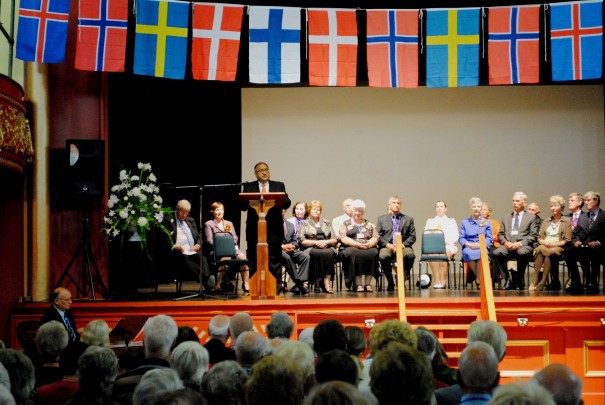Scandinavian Festival

For more photos, click here.
I begin by greeting everyone in the languages of the realm of New Zealand, in English, Māori, Cook Island Māori, Niuean, Tokelauan and New Zealand Sign Language. Greetings, Kia Ora, Kia Orana, Fakalofa Lahi Atu, Taloha Ni and as it is the evening (Sign)
I specifically greet you: Jean Thompson-Church, Convenor of the Scandinavian Festival and President of the Scandinavian Club of Manawatu; Your Worship Roly Ellis, Mayor of Tararua, and your wife, Philippa; Jim Jefferies, Deputy Mayor of Palmerston North, and your wife Alison; John Hayes, Member of Parliament for Wairarapa, and your wife Helen; Harvard Austad, representing the Embassy of Norway in Canberra; Graeme Mitchell, Honorary Consul-General for Norway, and Judy Whitcher; Manahi Paewai, kaumātua for Rangitane o Tamaki nui a Rua and Mrs Ataneta Paewai; Peter Mannix, MC for the evening; distinguished guests, ladies and gentlemen.
It was with great pleasure that my wife Susan and I accepted the invitation to attend this Scandinavian Festival here in Dannevirke.
I have been asked to officially open this festival, but before I do, I would like to speak a little of this area’s Scandinavian ancestors, their contribution to New Zealand and the lessons that their lives give to us today.
While I was born in Auckland, my parents came to New Zealand from Fiji when they were young people—my father to study to become a doctor and my mother to train to be a Plunket nurse. So the experience of being a newcomer in New Zealand—of surveying the landscape and working out how to fit in—is just one generation away for me.
For most New Zealanders of Scandinavian ancestry, that experience happened much earlier in the late 19th century, so it is somewhat harder to imagine what it must have been like for their forebears arriving here.
What we do know is that this part of the country was covered in dense native bush and that the immigrants had to clear it before they could build their homes and start their farms.
In fact, I understand that this is one of the reasons the government had specifically sought out Scandinavian settlers. According to Carl Walrond, who wrote the official entry about New Zealand’s Scandinavian Diaspora in Te Ara, New Zealand’s official online encyclopaedia, Bishop Monrad, a former Prime Minister of Denmark, settled in the Manawatu in 1866 with his family and five young Danish men.
They set about clearing the bush, and the quality and energy of their work apparently helped convince the Colonial Treasurer, Sir Julius Vogel, that Scandinavians were great bush clearers.
As a result, Vogel targeted Scandinavians in his “assisted immigration” scheme. By 1875 when organised immigration ended, about 3300 people had come from the Scandinavian countries, most coming from Denmark.
They received a subsidised passage and 40 acres of land, at one pound an acre. They could pay this off by working on road and rail construction, but this meant that because the men were working away from home, their own home and farm building projects were delayed.
In Te Ara Mr Walrond points out that farms were drawn by ballot, so although there were more Norwegians in Norsewood and more Danes in Dannevirke, the nationalities became mixed.
Danish, Norwegian and Swedish settlers would have found themselves with neighbours whose language they did not speak. The Scandinavian languages do, at least, have a common root. They would have had a much more difficult time with English and Māori!
The point I am making is that communication with most of the people with whom they came into contact would itself have been a challenge. Dame Margaret Clark, Emeritus Professor of Political Science at the Victoria University of Wellington, has noted that: “For all our forebears, simply coming here was an act of courage.” I think it is fair to say that both courage and communication skills were key ingredients in the social landscape of nineteenth century New Zealand.
Of course courage and good communication skills remain key ingredients for negotiating life in New Zealand today. In our own century, when people from a greater variety of ethnic backgrounds are arriving in the country, I believe that it behoves us to meet the courage they display with the communication skills we can bring to bear.
I would challenge people to continue to do that as they welcome new arrivals. The Scandinavian ancestors as new arrivals in this land eventually integrated. They often found it hard to believe what they saw in New Zealand, and in some cases, apparently, the people back home didn’t believe what they heard from returning Scandinavians who had spent time in New Zealand.
According to a story told in Te Ara, a Dane who settled here and later went back to Denmark for a visit ran into trouble with his own mother on this account.
“When he enthused about the wonders of the new land—its giant trees, flightless birds, prodigious grasses and the prowess of its sheep-shearers—his mother gravely informed him that his travels had turned him into a teller of tall tales.”
And on a note that refers to Scandinavian heritage, it gives me great pleasure to declare the Scandinavian Festival officially open.
And with my official duties complete, I will close in New Zealand’s first language, wishing you all good health and fortitude in your endeavours: No reira, tēnā koutou, tēnā koutou, kia ora, kia kaha, tēnā koutou katoa.
